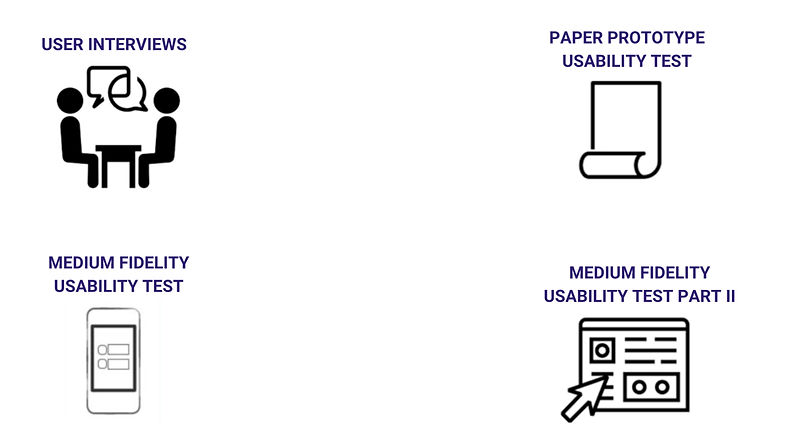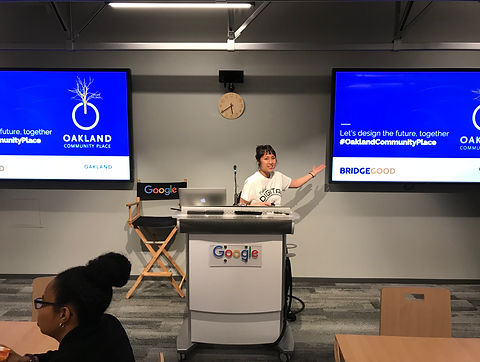
EXECUTIVE SUMMARY
CLIENT: Oakland Digital/Bridgegood
OBJECTIVE: Create a new member flow for nonprofits to reserve free event space.
OUTCOME: Client ecstatic with deliverables and is in the process of implementing the design solution.
HOW I CONTRIBUTED:
-
Provided UX Strategy
-
Led the design team
-
Facilitated user research
-
Built information architecture
-
Created UI copy

During our kick off meeting with the client, Shaun and Yudi, we presented our understanding of Oakland Digital through a concept map.
We had the client update the map through a white boarding exerise. Below is the outcome.
CONCEPT MAP


The Plan
BRIDGEGOOD is fundraising to secure a building in Oakland that aims to be a vibrant facility for nonprofits to host community events, trainings and workshops. Nonprofits will be able to use the space for FREE.
The Brief
We were tasked to create the application process that allows registered Bay Area nonprofits to use the community space.

Kick off meeting group pic
THE PROBLEM
Nonprofits are leaving Oakland due to increasing real estate costs. Without proper space, they cannot provide crucial services and resources to the community. Additionally, when coordinating available space, the process is long and inefficient.
Approximately 250 Bay Area nonprofits anticipate cost-related moves to cheaper areas

“We’re losing real community treasures — whether they’re arts programs or workforce development — that contribute to Oakland’s culture and to its uniqueness,” said Regina Jackson, President and CEO of the East Oakland Youth Development Center (EOYDC)
THE SOLUTION
Nonprofits can reserve FREE event space through BRIDGEGOOD’s Community Spaces encouraging nonprofits to stay local. The online application makes it easy for nonprofits to book space instantly. The application will provide a frictionless reservation process available on mobile and desktop.
MY ROLE
I led a team of three UX Designers during this project. My role was threefold as team lead, project manager, and ux designer. I led the agenda with client meetings, created and managed the project plan, and made sure the team had a balanced amount of work while sticking to the schedule. Below is an outline of some of my key contributions:
o Led UX Strategy for application/room reservation process for nonprofits
o Conducted user interviews and usability tests which informed design decisions
o Problem definition and information architecture
o Delivered wireframes, interactive prototype, and presentation to client
We focused our research on nonprofit workers. Devon was inspired directly from one of our nonprofit interviews.

Curated by Eric Ramirez
"I would like to recruit more students for the event, but now I have to scramble to find a new venue since the place cancelled on us."
- Devon, Mission Bit Program Manager
RESEARCH METHODOLOGY

We conducted four rounds of testing with a total of 18 participants
AFFINITY MAP

USER INTERVIEW INSIGHTS
-
Current nonprofit booking process is long and inefficient
-
Lack of accessible space for nonprofits
-
Nonprofit workers wear many hats and are out in the field, they need a solution that is dynamic and efficient
PAPER PROTOTYPE

Curated by Irene Pacheco
We each came up with a paper prototype and tested all three with users. We ended up taking the best of each prototype to create the next iteration.
USABILITY TEST PAPER PROTOTYPE INSIGHTS
-
Users liked details of rooms and amenities
-
Users preferred visuals and iconography
-
Flow of selecting a date was confusing
-
Emphasize the room is free for nonprofits
MEDIUM FIDELITY SCREENS




A sampling of med-fi screens
USABILITY TEST MED-FI PROTOTYPE INSIGHTS
-
Users were skeptical that space was free
-
Users wanted more details about the EIN and COI
-
Users wanted more pictures of the room
-
Users wanted to learn more about the membership and the process
OBSERVATIONS


From paper to high fidelity
INCORPORATING FEEDBACK



SITE MAP
HIGH FIDELITY SCREENS

Responsive site adjusts to device
CO-FACILITATING DESIGN THINKING EVENT

I had the honor of presenting our design process at the #OaklandCommunityPlace Design Thinking Event hosted by Google.org. We invited 40 nonprofits to brainstorm the future of Oakland Community Place. We dug deep and asked the nonprofits to share their most critical pain points and present their ideas on solutions.


A few issues we identified were around:
-
Tech/Tools
-
Volunteer Management
-
Space
The nonprofits had many ideas on the future and how to solve their most prominent issues.


Group Activity: What are our pain points?
Thanks to everyone who came through, especially Oakland Digital and the design team!
Solutions presented by nonprofits
-
Clearly defining nonprofits vision and mission to attract and retain volunteers
-
A volunteer run tech help hotline where nonprofits can call to ask for tech help
-
Envisioning a workspace that is open and wide so that nonprofits have room to create
